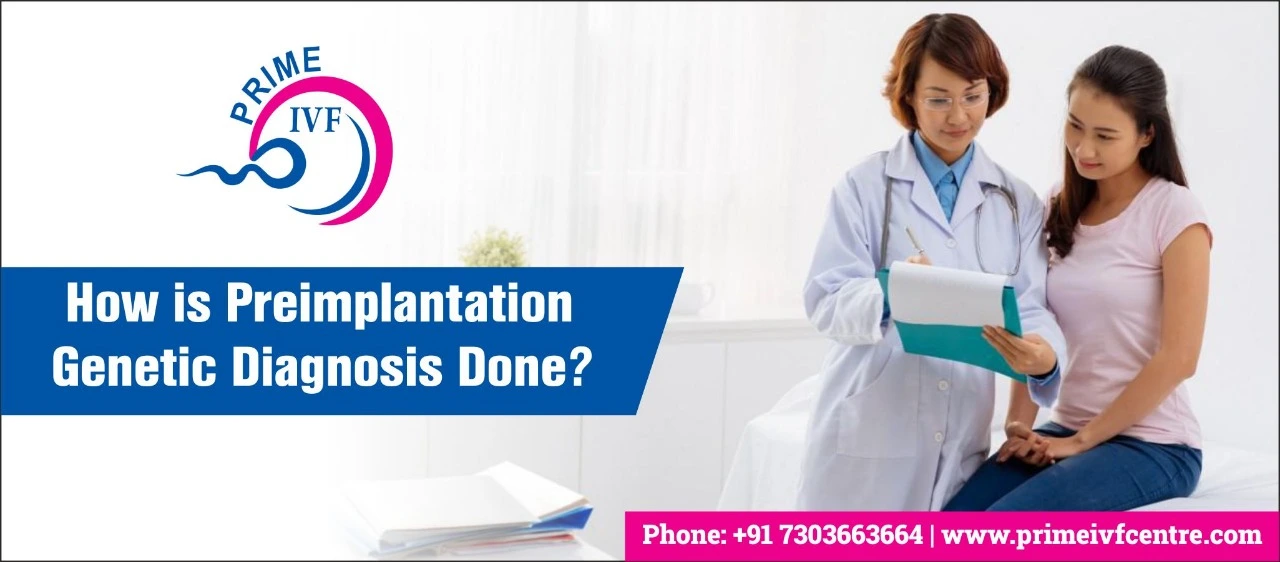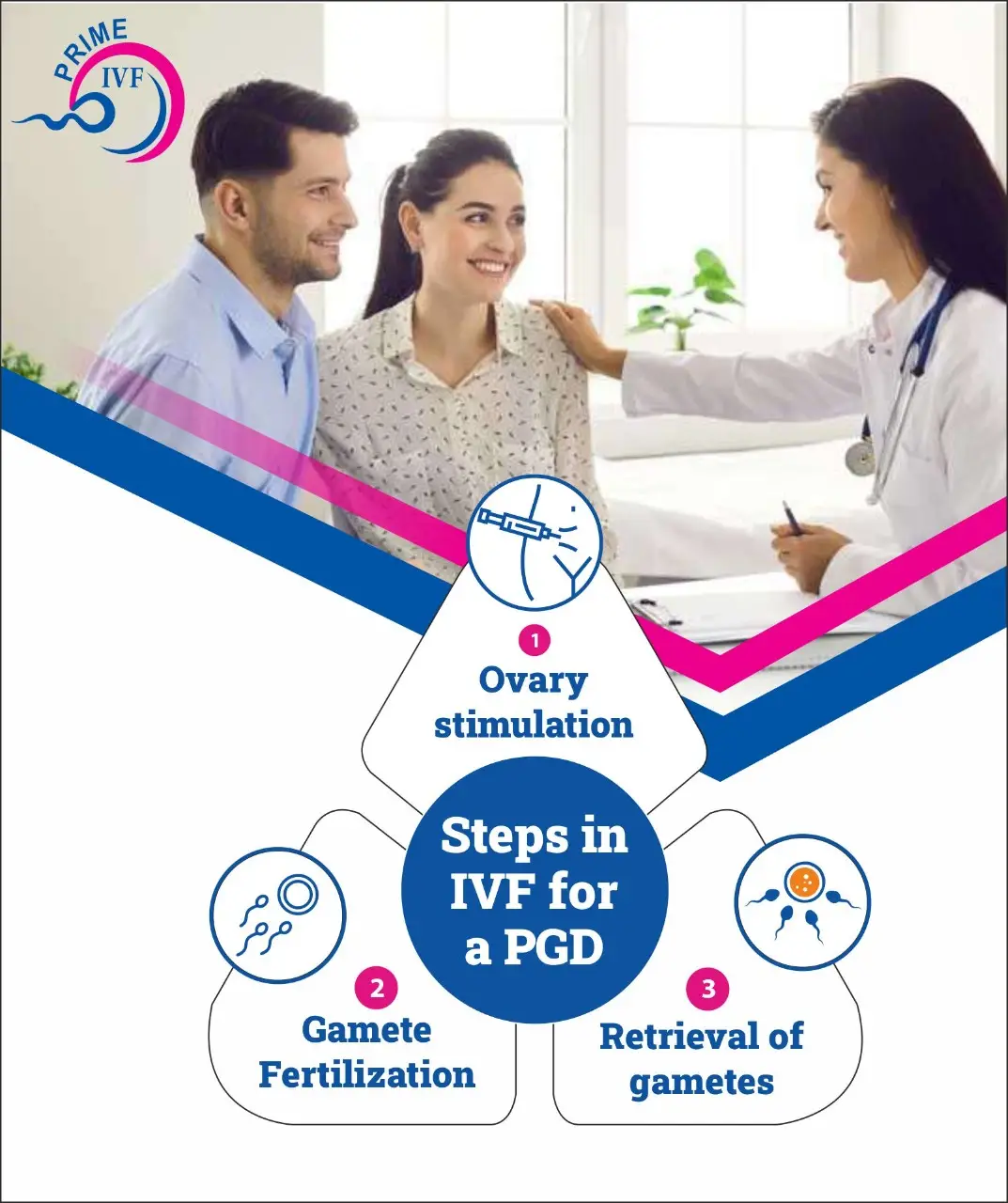How is preimplantation genetic diagnosis made?

- 20 Apr, 2022
- IVF and Infertility
- infertility
- Medically Reviewed By:
 Dr. Nishi Singh
Dr. Nishi Singh - Author: Prime IVF Centre
With evolving techniques in IVF, preimplantation genetic testing of embryos and oocytes has become an inevitable part of advanced IVF technology. If you are planning for an IVF treatment and the maternal age is above 35 for pregnancy, you will be suggested for a preimplantation genetic diagnosis or PGD.
PGD is the testing of the IVF embryos or oocytes during its preimplantation stage for genetic defects. It is crafted for couples who are at risk of inheriting genetic disorders or chromosomal abnormalities. PGD is a mandatory procedure for frozen embryo transfer or FET.
The key advantage of PGD is- It helps eliminate the risk of having a child with genetic disorders at the embryo stage itself. This article deep dives into everything you need to know about preimplantation genetic diagnosis or PGD treatment in Delhi.
Table of Contents
Feel free to skip ahead if one topic catches your eye
1. What Is Preimplantation Genetic Diagnosis (PGD)?
Preimplantation Genetic Diagnosis (PGD) is a procedure done to identify the genetic defects in the embryos created through IVF before embryo transfer implantation.
PGD is designed to detect specific genetic disorders in the IVF embryos passed by their parents. By checking the embryos, the chances of passing genetic defects, including HIV, are reduced.
Some of the commonly diagnosed disorders by a preimplantation genetic diagnosis in Delhi and elsewhere include:
- Reproductive cancer-causing BRCA1 & BRCA2 gene mutations,
- Cystic fibrosis (CF),
- Sickle cell anemia,
- Hemophilia A,
- Huntington’s disease,
- Duchenne muscular dystrophy (DMD),
- Fragile X syndrome,
- Myotonic dystrophy,
- Spinal muscular atrophy,
- Human Immunodeficiency Virus (HIV) and many more.
Some of the benefits of PGD outweighing the downsides include:
- Allows fertilizing the embryos that are free of genetic disorders or conditions.
- Parents with genetic disorders or carriers of the genetic defect can conceive with a low risk of passing the disease to their child.
- The chances of a successful IVF increase as the most viable and fit embryos are picked for embryo transfer.
2. Why Is It Performed?
PGD focuses on mitigating the risk of passing a genetic defect or chromosomal anomalies to the child. PGD is preferred and performed during an IVF, especially in the following cases.
- Intended parents with a family history of X-linked disorders like fragile X syndrome
- Couples who have had recurrent pregnancy loss or implantation failures due to chromosomal defects of the embryo
- Parents who are carriers for an autosomal dominant, recessive condition like sickle cell disease, Huntington's disease, or other X-linked disorders
The risk of passing on the disorder for autosomal recessive is 25% but, in the case of the autosomal dominant condition, it is 50%.

3. What is the Procedure of Preimplantation Genetic Diagnosis (PGD)?
The procedure of PGD is performed during an IVF. Once the genetic counselor or a geneticist assesses the risk of passing on the genetic condition to their offspring, the following steps of IVF are followed by embryo biopsy procedures to derive embryo cell samples for testing and genetic testing procedures.
Steps in IVF for a PGD
- Ovary stimulation: The ovaries are hormonally stimulated to produce enough follicles and mature eggs.
- Retrieval of gametes: The egg is retrieved directly from the developed ovarian follicles through a small surgical procedure. While the sperms are retrieved on the same day by natural ejaculation or surgical sperm aspiration techniques.
- Gamete Fertilization: The egg and the sperms are mixed and fertilized in a laboratory. Intracytoplasmic Sperm Injection or ICSI also can be performed where sperm is directly injected into the egg microscopically.
While the embryos are allowed to develop in a culture medium in incubated conditions, the cleavage stage embryos, or blastocyst stage embryos are used for PGD analysis
Embryo biopsy techniques in PGD
- Cleavage stage embryo biopsy- At day three of fertilization, a small blastomere cell of 6-10 cell stage embryos is extracted for testing.
- Blastocyst biopsy- The blastocyst stage embryo has more than 100 cells defined by outer and inner cell mass. Cells from the outer cell mass or trophectoderm are extracted for further genetic testing.
Genetic testing procedures in PGD
- Polymerase chain reaction (PCR): PCR is a relatively faster method of DNA testing where a strand of DNA is amplified to check for genetic mutations in single-gene disorders, autosomal dominant, and recessive disorders.
- Fluorescent in situ Hybridization (FISH): FISH is usually considered for X-linked disorders, chromosomal aberrations, and aneuploidy screening. Here, fluorescent markers that bind to specific mutated chromosomal segments are used to analyze the DNA.
- Comparative genomic hybridization (CGH): A comprehensive technique used to analyze all the 23 pairs of chromosomes using a control cell and fluorescent markers. However, this technique takes a longer time (72 hrs). And so, the embryos will need to be cryopreserved till the analysis and embryo transfer are performed.
The PGD analyzed, nonaffected, structurally normal embryos are transferred into the uterus for further IVF implantation and pregnancy.
4. What is the Difference Between PGD and PGS?
Here’s a quick breakdown of the differences between PGD and PGS.
|
PGD |
PGS |
|
PGD stands for preimplantation genetic diagnosis. |
PGS stands for Preimplantation genetic screening. |
|
PGD refers to a specifically designed test performed on an embryo created through IVF when one or both the parents have or are carriers for a genetic defect. It helps determine whether or not the child is likely to have any genetic abnormality. |
PGS is a screening test done to analyze the likelihood of the embryos developed through IVF having a genetic defect when both the parents are presumed to have no genetic defects. |
|
PGD is done if,
|
PGS is performed in cases where,
|
Takeaway
Preimplantation genetic diagnosis in Delhi, and other places is an extended procedure of IVF done to select a more healthy and viable embryo by eliminating embryos having genetic defects. The procedure includes an embryo biopsy of the embryos developed via IVF followed by genetic testing procedures like PCR, FISH, or CGH.
If you are in Delhi and want to get a PGD done, Prime Infertility Center provides qualitative PGD analysis with the most affordable preimplantation genetic diagnosis in Delhi. Prime Infertility Center is established by a team of very passionate, highly experienced, committed doctors. Prime IVF practices high ethical standards, complete transparency, and affordable treatment services to provide comprehensive infertility solutions to couples under one roof.
FAQs
PGD helps diagnose single-gene disorders like
- Cystic Fibrosis,
- Sickle Cell Anemia,
- Spinal Muscular Dystrophy,
- Tay-Sachs disease,
- Hemophilia,
- Thalassemia,
- Phenylketonuria,
- Fragile X syndrome, and many more.
PGD permits the placement of healthy, chromosomally fit embryos during the IVF procedure. The preimplantation Genetic Diagnosis cost in Delhi is more than Rs. 5,000 per embryo. However, the cost is subject to change depending on the laboratory and other factors.
PGD does require a cell or two of the developing embryo for analysis. However, the extraction of cells does not affect the embryo or its developmental process.


Smile
10-Nov-2023I and my husband are thalaessimia carriers. We hade two abortion since the foetus was thalaessimia. What we need to do further for healthy baby?